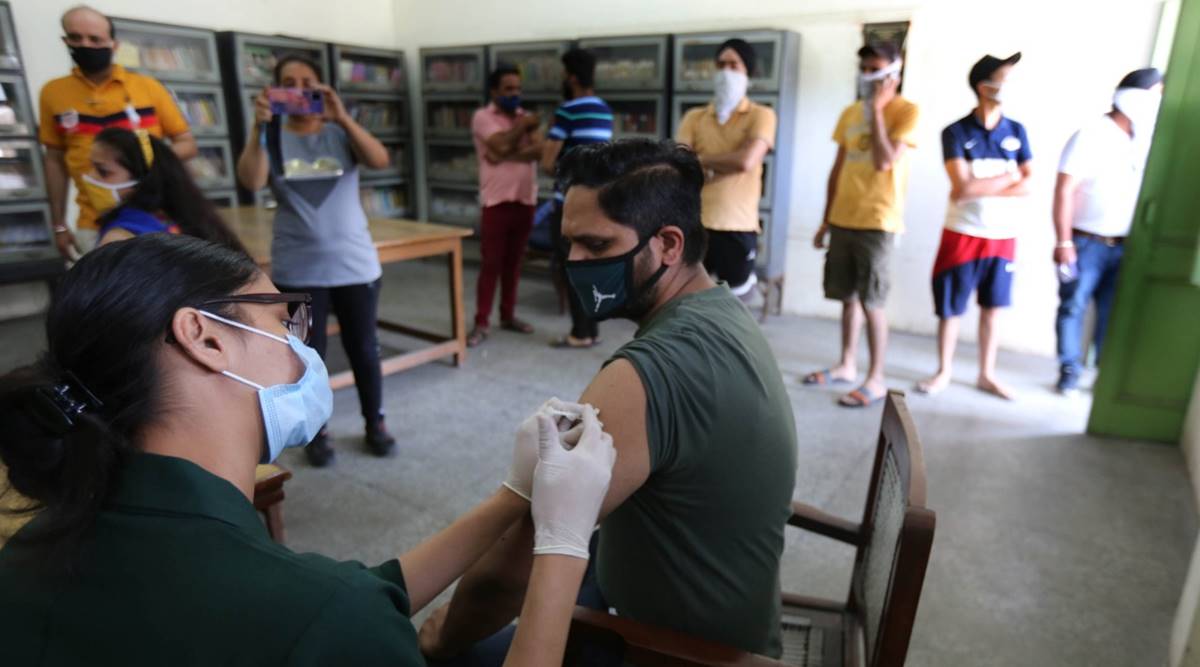 A person being vaccinated against COVID-19 in Ludhiana. (Express Photo by Gurmeet Singh)
A person being vaccinated against COVID-19 in Ludhiana. (Express Photo by Gurmeet Singh) Orchestrating the narrative seems to be a national obsession. Polemics and social media posts blur the picture, making it difficult to sift truth from falsehood. So why should a political journalist be presumptuous enough to jump into the vaccine story? My slight advantage is having gained a perspective while researching for a book on Parsis, long before the coronavirus hit the world. The founder of the Serum Institute of India, the world’s largest manufacturer (in terms of dosages, not turnover), Cyrus Poonawalla, belongs to the community.
How did India become the world’s vaccine capital? Was it because of governments, past or present, or despite them? If we look at the narrative from one angle, former PM Morarji Desai could be credited with giving the big boost to our vaccine industry. Desai, the dour, ascetic chief minister of Bombay state, banned Bombay’s lucrative horse-racing industry which forced the Poonawalla family, which owned stud farms, to look for an alternative source of livelihood.
SII was the focus of international attention when the pandemic broke because of its reputation for high quality, low costs and a huge production capacity, the Gates Foundation and UNICEF being its major clients. Post-Covid, SII was offered numerous foreign collaborations but it chose to partner with AstraZeneca, to which Oxford University had provided its vaccine research on the assurance that AstraZeneca would make the vaccine available to poorer countries. In early 2020, SII struck a deal to produce a billion doses for developing countries, including India.
Adar Poonawalla, SII CEO, took the gamble of kick-starting the manufacturing process and expanding production facilities, investing his own money besides some $600 million from GAVI and other international philanthropic bodies. The understanding was that SII would supply 100 million doses of AstraZeneca to 92 countries, apart from its commitment to India. Adar was confident that he would produce more than a billion vaccine doses by 2021. By the end of December 2020, SII had stockpiled 200 million doses, even before the Indian health authorities had cleared the vaccine for use.
SII was touted as an example of Atmanirbhar Bharat, though its funding and patent were foreign. In the past, foreign multinational pharma companies have accused SII of piggybacking on their research. Even SII’s state-of-the-art production facilities are imported largely from the West. A more inspiring example of Atmanirbhar Bharat was a little-known Hyderabad firm, Bharat Biotech, founded by scientist Krishna Ella, which teamed up with the ICMR in 2020. Despite the cynics, Opposition criticism and a shortage of funds, it came up with a viable and efficacious winner in Covaxin. Ella is quoted as saying, “I didn’t get any money from the Gates Foundation or from the Government of India’’.
At the beginning of the year, the narrative was that India was going ahead with the world’s largest vaccine programme with confidence, by banking on two trusted vaccines. Health Secretary Rajesh Bhushan claimed three weeks after the start of the vaccination drive that India was the fastest to reach the five million mark in 21 days. He failed to take into account that five million was a drop in the ocean for a country of 1.4 billion. Two months were frittered away on a leisurely search for health and frontline workers, many of whom did not show up. V K Paul, head of the Covid Task Force, declared triumphantly that the government was confident in its delivery system.
Unfortunately, Paul failed to do his elementary sums. SII was producing about 60 to 70 million doses a month and Bharat Biotech at best 15 per cent of this number. Once the vaccine was opened to all above 60 in March, a reality check set in. Our biggest assets, two indigenous vaccine producers, were unable to meet demands because they had been provided no incentive to expand facilities by the government, which has also not thought of offering Covaxin’s IPR to other Indian manufacturers. It was only in April that the government finally provided adequate financial incentives to the two manufacturers, something it should have had the forethought to do at least six months earlier, following the example of the US and Europe. Moreover, by purchasing the vaccine at Rs 250, of which Rs 100 was the hospital’s share, we were crushing, not incentivising vaccine manufacture in India. Only businesswoman Kiran Mazumdar-Shaw was forthright enough to point this out.
The central vaccine task force finally woke up to the fact that there was going to be a serious vaccine shortfall by late April. Unfortunately, some Opposition states played into the Modi government’s hands by the populist demand that the vaccine drive be opened to all above the age of 18. The Centre was happy to oblige. Instantaneously, it abdicated its responsibility, perhaps aware that in the chaos which would follow such a move, the blame would now have to be shared by the Opposition governments and the Centre.
A reality check is beginning to register. State governments are waking up to the fact that foreign vaccines would remain unavailable for several months. The Centre has additionally rigged the game by imposing an unequal pricing formula for domestic vaccines. In the bargain, the positive point of our initial vaccine programme, equitable and relatively fair distribution of vaccines, has been jeopardised in the mad scramble. Paul, who likes to look at the bright side, now promises two billion vaccines by year-end. The vaccine famine in the interregnum is glossed over.
Postscript: In the vaccine narrative, there is an issue which needs mentioning. Many were indignant over the export of vaccines early this year to exotic places like Bermuda and Bhutan, while the Ministry of External Affairs gushed over vaccine diplomacy. To my knowledge, these limited supplies were part of the fully paid-for commitment of advance bookings by the international community and had nothing to do with the GoI, which gratuitously sought to take appropriate credit. Since late March, all such vaccine exports stand cancelled.
The writer is consulting editor, The Indian Express
- The Indian Express website has been rated GREEN for its credibility and trustworthiness by Newsguard, a global service that rates news sources for their journalistic standards.


